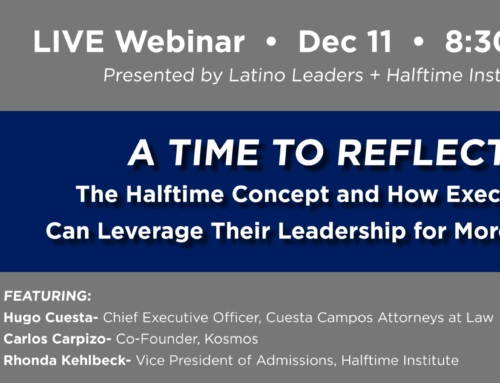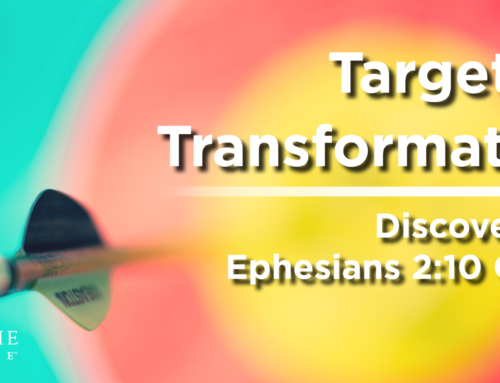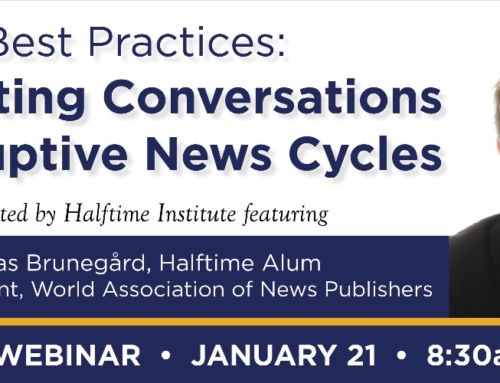Success in the halftime journey doesn’t just happen. It takes planning and persistence, and it has several elements that are critical to your success. Let’s zero in on three of them for the time being: A personal board of directors, a strong mission statement, and coaching.
Personal Board of Directors
The first time I heard Bob Buford mention a personal board of directors, I thought to myself, “I’ve got that.” He was talking about a panel of trusted family, friends, and colleagues—people to speak truth into our lives. My board was informal, but I’d long had a go-to group for wisdom, commentary, and, as needed, unwanted honesty.
My first unofficial board member was Paul Wilson, whose friendship had overturned my life. On relationship issues, Paul is my first stop. If it’s about my son or daughter, I ring up Eric Thornton, a former youth leader and a good friend. For anything to do with my work/ministry, it’s Jeff Spadafora, my Halftime coach and dear friend. Dick Anderson, now with ORPHANetwork, escorted me open-eyed into the realities of not-for-profit work and has been a trusted mentor through the transition from the marketplace. Through the years and the circumstances some “members” have rotated in or out, but I’ve long known it’s foolhardy to go it alone.
Your board may be formal or informal, meet frequently or as needed, be as small as three people or as large as seven (I wouldn’t go larger). Here are a few more recommended criteria.
Paul McGinnis, Halftime Institute’s COO and Certified Halftime Coach recently wrote 2 articles that will illuminate more fully the why behind a Personal Board of Directors and how to form one:
It takes some time and focus to establish this group, but trust me it is worthwhile to have honest, personal feedback on the journey.
Your Mission Statement
In your short, sweet-spot statement of purpose, your strengths, spiritual gifts, and passions come together in one answer to three questions.
- Gifts. What are my strengths?
- Group. What group do I want to serve?
- Goals. What outcome do I wish to see?
This twenty-eight-word example has all three categories: To use my entrepreneurial skills to create training and jobs for women coming out of prostitution so that they can become financially self-sufficient, connect in community, and grow mentally, socially, and spiritually.
On the front end, mission statement drafts are wordy and unwieldy. Not to worry. You’re getting ideas down, so say everything you need to say. Once it’s all down, look for repetition and extra words. Consider where you can condense ideas. Stay at it until, in fifty words or fewer, you can state your strengths, your target mission group, and your desired outcome. Besides making your mission easier to memorize and bring to mind any time, brevity forces clarity. And clarity sweeps out confusion.
My twenty-six word mission statement is “to inspire and encourage high-capacity leaders on a journey to identify their Ephesians 2:10 calling and engage in the issues Jesus cares about.”
Coaching
Just think about it. Every great athlete has a coach. For example, great golfers have swing coaches, and here’s why. Blind spots. You can’t fix what you can’t see and it takes someone looking at us and being honest to tell us how to fix what’s not working. And, you have to be humble enough to accept their advice and counsel.
Another aspect of having a coach is this: What do we do with the unvarnished truth when we hear it? It requires action from us, or else we will continue heading in the wrong direction and probably waste a lot of valuable time and resources. And, it’s going to take work and dedication.
One year at our leadership team meeting, on a floor right below the Halftime offices, our then our full-time coaches stole away for an ad hoc conversation. Their talk quickly narrowed to the topic of dropouts. Popping up and down at a big table in a small room, the four men turned the room’s whiteboard to a rainbow of colors, all on one mystery: Why do some Halftimers reach their goals while others drift away? What makes some persevere and some disappear?
Why would type A men and women—high achievers, non-quitters, goal-oriented marketplace mavens—give up on anything, particularly on their dreams for significance?
At the table that day ideas flew and early hunches fell away. The problem wasn’t the Halftimers’ schedules. Dropouts showed no consistent patterns related to study, prayer, low-cost probes, or any of the disciplines.
The problem didn’t trace to the state of a Halftimer’s marriage, or whether it needed help. Finances? Too much money or too little? Nope. No consistent factors in income or outgo were a reason to give up. As for faith, people of strong faith stayed in, and people of strong faith drifted out. No indicators there.
Still, a good number of Halftimers wound up ghosting their programs. There had to be an indicator. And then there was. Interestingly, it was a two-parter. Part one was timing: Halftimers who abandoned their dreams did it in months five through eight of their program. Part two was coaching. Of all the people who saw their dreams through to completion, nearly every single one had stayed with a coach. Of the people who had left, all had left coaching.
Why months five through eight? In the Halftime first-year journey, those are the months when dreams of a new season of life hit a patch of hard work, risk, sacrifice, and inconvenience. Egos take bruises. For a long time you’ve been king of the hill. Now you’re trying new things and eating some humble pie. Instead of strategy, tactics and execution, you’re in a world of trial, risk, and some dead ends.
No question, this halftime journey can be a tough go. But I can tell you that it’s all worth it. These three elements-your personal board of directors, your clear and concise mission statement, and a great coach will get you there.
Next time: Perfect life metrics and a roadmap






